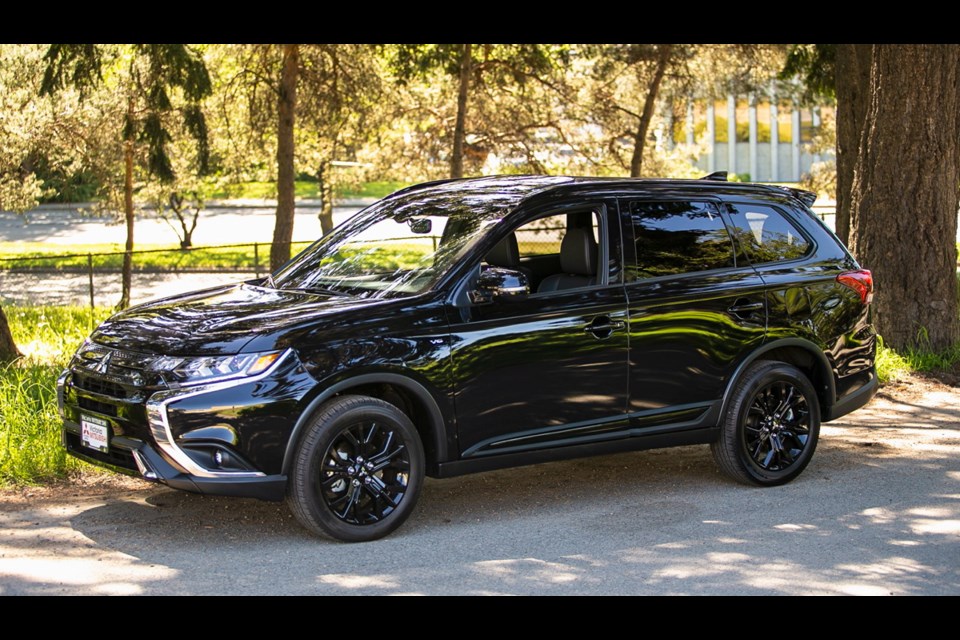With all the hype around electrification of the 2019 Mitsubishi Outlander, it is easy to forget the other attributes of its internal-combustion brethren.
The Mitsubishi Outlander P-HEV is garnering an undue amount of attention these days, thanks to its ability to run on a combination of electricity and gasoline. With recently announced federal incentives (and few competitors), interest in the P-HEV is high.
But lost in the rush are the two conventional gasoline-powered Outlanders, which appeal to two different crowds.
The base Outlander ES AWC, with a manufacturer’s suggested list price of $29,198, comes equipped with a 2.4-litre four-cylinder engine and 16-inch wheels.
My tester today is the SE AWC Black Edition, with a list price of $35,998. (The Black Edition is a SE AWC with black wheels, grille, door mirrors, roof rails — you get the idea).
But the biggest difference between the SE and lesser Outlanders is the presence of a 3.0-litre V-6 under the hood, coupled with a six-speed automatic transmission.
While the 2.4-litre four can best be described as adequate for the job, the 224 horsepower and 215 pound-feet of torque generated by the V-6 places makes it almost unique.
The Outlander is a compact SUV, a segment dominated by the likes of the Honda CR-V, Toyota RAV4 and Subaru Forester.
This is a segment that has abandoned offering V-6s in their lineups, with a few opting for turbocharging their four-cylinders for more power.
The old saying that “there is just no substitute for cubic inches” applies here. The V-6 Outlander outpowers its competition.
The V-6 can tow up to 1,587 kilograms (3,500 lbs.), more than double the competition. If you have a camper or trailer, this is a definite plus.
It also has a conventional six-speed automatic, not a continuously variable transmission — another attribute for successful towing.
The SE AWC Black Edition also comes standard with all-wheel drive, with three driver-selectable modes: Eco, Auto and Lock.
The last mode is one not always found on off-road-capable SUVs. When engaged, the electronically controlled coupling maintains a 50/50 power split between the front and rear wheels. It is ideal for actual off-road driving and useful for getting the vehicle unstuck in mud and snow.
Apart from the base model, all other Outlanders offer a bonus in the form of seven-passenger seating in three rows, a feature long abandoned by the compact SUV crowd.
Make sure your third-row occupants are small — the rearmost seats lack almost any leg or headroom for a regular-sized adult when the second-row seats are at their rearmost position. The second-row seats can slide forward, giving the rear occupants more space for their cramped legs.
As if to compensate, the fold-down seats fold flat, with 1,792 litres of cargo room with both rear seats folded.
Be aware, there is no spare tire: Mitsubishi includes an inflator kit, instead. The slot under the floor in the trunk has a cutaway that allows you to store the retractable cargo cover. It is a nice touch when you are using the rear to haul cargo.
The cabin is well appointed, with a power glass sunroof, heated steering wheel, (artificial) suede inserts in the seats, power folding side-view mirrors, dual-zone climate control, rain-sensing windshield wipers and a power liftgate.
Safety features include blind-spot warning system, lane-change assist, rear cross-traffic alert and LED head and fog lamps.
The only feature I miss is the forward collision mitigation, which is only available in the top-of-the-line GT-S model.
On the road, the cabin is serene, with little road noise intruding. The infotainment system is controlled by a seven-inch touchscreen mounted at the top of the centre stack. Apart from the steering-wheel mounted controls, there is a solitary (if a little small) volume control knob on the dash.
The system supports Apple CarPlay and Android Auto — bravo. The audio system also comes with SiriusXM satellite radio in even the least expensive model, which is a nice bonus.
I should end with a mention the Mitsubishi warranty coverage is arguably the best in the business. It offers a five-year, 100,000-kilometre new-car warranty, 10-year/160,000 km powertrain warranty and five-year, unlimited km roadside assistance.
THE SPEC SHEET
Type: Compact seven-passenger SUV, front engine, all-wheel-drive
Engine: 3.0-litre V-6, 224 hp at 6,250 rpm, 215 lb.-ft. of torque at 3,750 rpm
Transmission: Six-speed automatic
Dimensions (mm): Length, 4,695; width, 1,810; height, 1,710; wheelbase, 2,670
Curb weight (kg): 1,600
Price (base/as tested): $36,298/ $38,223 (includes $1,825 freight and PDI and $100 AC tax)
Options: Nil
Tires: 225/55 R 18 on alloy wheels
Fuel type: Premium
Fuel economy (L/100km): 12.0 city/ 8.8 highway
Warranty: Five-year/100,000 kilometre new car warranty,10-year/160,000 km powertrain warranty and five-year/ unlimited km roadside assistance.



